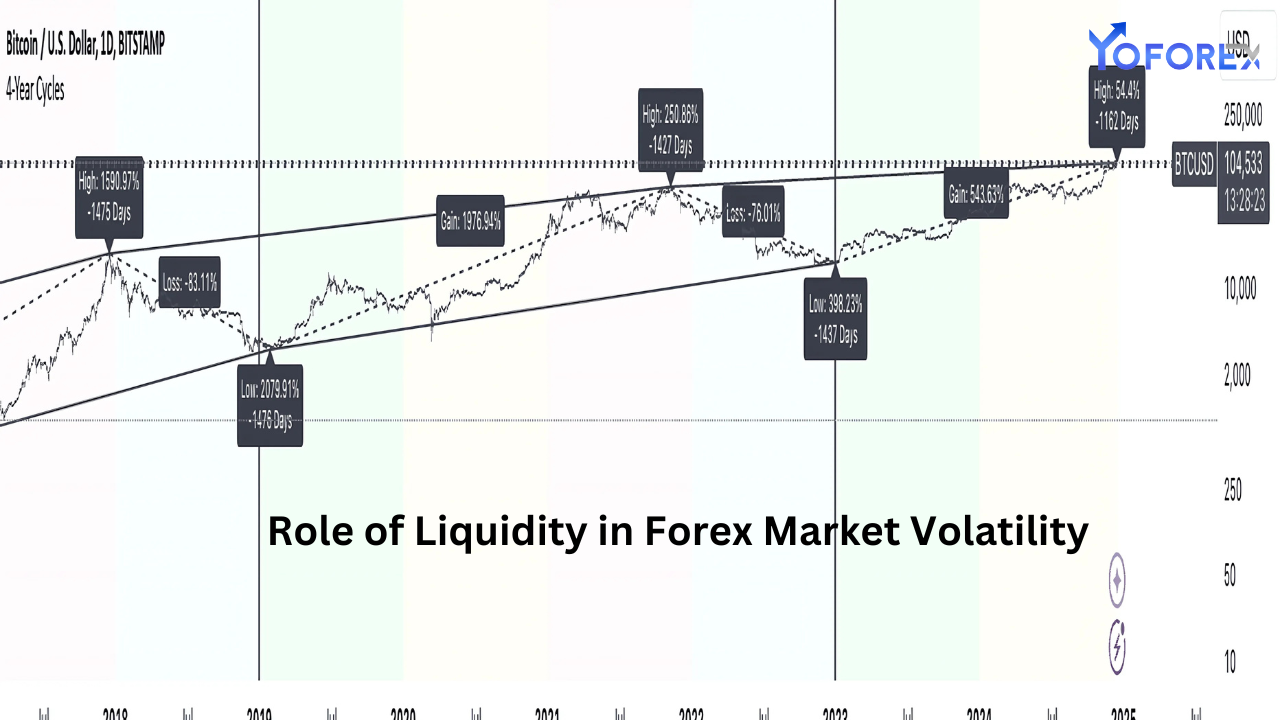The forex market is the largest and most liquid financial market in the world, with an average daily trading volume exceeding $7 trillion. Liquidity, or the ability to buy or sell a currency without causing a significant price change, plays a pivotal role in shaping market volatility. Understanding the relationship between liquidity and volatility is crucial for traders aiming to navigate the forex market effectively. This blog explores the role of liquidity in forex market volatility, its causes, and how traders can adapt their strategies to capitalize on this dynamic.
What is Liquidity in the Forex Market?
Liquidity refers to the ease with which a currency pair can be traded without significantly impacting its price. High liquidity means there is a large volume of buyers and sellers in the market, ensuring smooth transactions and stable price movements. Conversely, low liquidity indicates fewer participants, which can lead to erratic price behavior and increased volatility.

Factors Influencing Liquidity in the Forex Market
Several factors influence liquidity in the forex market, including:
- Trading Sessions:
- The forex market operates 24 hours a day across different time zones. Liquidity peaks during overlapping trading sessions, such as the London-New York overlap.
- Currency Popularity:
- Major currency pairs like EUR/USD, GBP/USD, and USD/JPY tend to have higher liquidity due to their widespread use in global trade and finance.
- Economic Data Releases:
- High-impact economic events and news releases can temporarily increase liquidity as traders enter the market to capitalize on new information.
- Market Participants:
- The presence of institutional investors, central banks, and retail traders affects liquidity levels. Institutional investors typically bring higher liquidity compared to retail traders.
- Holidays and Off-Hours:
- Liquidity diminishes during major holidays or outside regular trading hours, leading to thinner markets and potential price spikes.
The Link Between Liquidity and Volatility
Liquidity and volatility share an inverse relationship in the forex market:
- High Liquidity, Low Volatility:
- During periods of high liquidity, such as overlapping trading sessions, the abundance of market participants ensures smoother price movements. Large buy or sell orders are absorbed without causing significant price changes, resulting in low volatility.
- Low Liquidity, High Volatility:
- In low-liquidity conditions, such as after-market hours or during holidays, fewer participants mean that even small orders can cause substantial price swings, leading to high volatility.
Scenarios Where Liquidity Drives Volatility
- News Announcements and Economic Data:
- Major events like central bank interest rate decisions or geopolitical developments attract heavy trading activity. Initially, liquidity may surge as traders react, followed by a drop once the initial market response subsides, resulting in volatile price movements.
- Thin Markets:
- During off-peak hours or holidays, thin markets with low liquidity can experience exaggerated price movements. For example, the Asian trading session is generally less liquid compared to the London or New York sessions, leading to higher volatility for some currency pairs.
- Flash Crashes:
- Sudden liquidity shortages can trigger flash crashes, where prices drop precipitously within minutes before rebounding. These events highlight the critical role liquidity plays in maintaining market stability.
How Liquidity Impacts Forex Traders
Understanding liquidity is vital for forex traders because it affects key aspects of trading:
- Spread Costs:
- High liquidity reduces bid-ask spreads, making trading cheaper. Low liquidity, on the other hand, widens spreads, increasing transaction costs.
- Slippage:
- In low-liquidity markets, traders may experience slippage, where orders are executed at a price different from the expected level. This can significantly impact profitability.
- Trade Execution:
- High liquidity ensures smoother and faster trade execution. In contrast, low liquidity may lead to delayed executions and unfavorable price levels.
- Risk Management:
- Liquidity levels influence risk management strategies. High volatility resulting from low liquidity requires traders to adjust position sizes and use tighter risk controls.
Strategies for Trading in Different Liquidity Conditions
Traders must adapt their strategies based on liquidity levels to manage risks and capitalize on opportunities effectively. Here are some approaches:
- Trade During High Liquidity Periods:
- Focus on trading during overlapping sessions, such as the London-New York overlap, to benefit from tighter spreads and smoother price movements.
- Avoid Illiquid Markets:
- Refrain from trading during holidays, weekends, or off-peak hours to avoid erratic price behavior and wider spreads.
- Monitor Economic Calendars:
- Stay informed about scheduled economic events that could temporarily increase liquidity and volatility. Plan your trades accordingly.
- Use Pending Orders:
- In volatile markets, consider using pending orders like buy stops or sell stops to execute trades at desired price levels, minimizing the impact of slippage.
- Adjust Position Sizes:
- Reduce position sizes during low-liquidity periods to limit exposure to unpredictable price swings.
- Hedge Positions:
- Use hedging strategies to protect against adverse price movements in low-liquidity markets.
Tools to Track Liquidity and Volatility
Traders can use various tools to gauge liquidity and volatility levels:
- Volume Indicators:
- Volume indicators show the number of trades executed over a specific period, providing insights into market activity and liquidity.
- Volatility Indicators:
- Tools like Bollinger Bands, Average True Range (ATR), and standard deviation measures help assess volatility levels.
- Economic Calendars:
- Monitor economic calendars for high-impact events that could affect liquidity and volatility.
- Order Book Analysis:
- Some trading platforms offer order book data, revealing the depth of market liquidity at different price levels.
Conclusion
Liquidity is a fundamental factor that shapes the forex market’s behavior. Its influence on volatility underscores the importance of understanding market dynamics for successful trading. High liquidity often translates to stability and lower costs, while low liquidity brings the challenge of navigating volatile and unpredictable markets.
By staying aware of liquidity levels and their impact on volatility, traders can refine their strategies, optimize trade execution, and manage risks effectively. Whether you are a seasoned trader or a beginner, incorporating liquidity analysis into your trading approach can enhance your ability to navigate the complex and dynamic world of forex trading.

